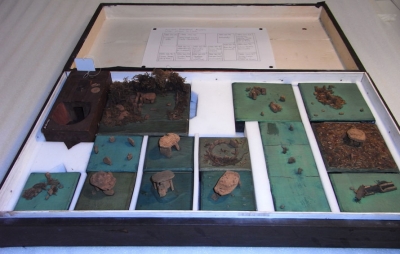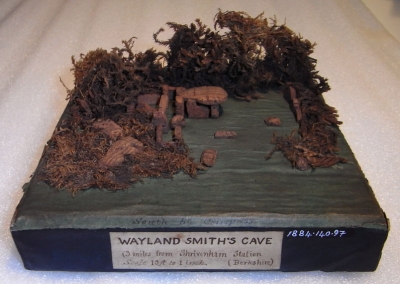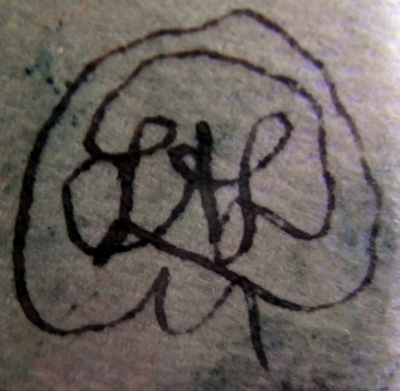To search the RPR site click here
Model monuments
A set of models of prehistoric stone monuments
Caroline Butler (MSc Professional Archaeology)
Hidden away in a box in the Pitt Rivers store rooms are a set of 13 models depicting various megalithic monuments from England and the Isle of Man. All the models (accession nos. 1884.140.85-97) are made from the same materials, at the same scale with very similar information recorded on each. They first arrived at the museum as part of the founding collection in 1884, but had previously been displayed at the Bethnal Green and South Kensington museums.
The 'Green book' holding the South Kensington museum receipts has an entry dated 25th February 1875 for “16 cork models of Prehistoric monuments”. Clearly some have gone astray but in the delivery catalogue most are listed as being displayed in case 43, so they were on show as part of the Pitt Rivers collection at Bethnal Green and later South Kensington Museums. The 16 models fall into 3 groups: sites in Devon and Cornwall; sites on the Isle of Man; Other sites. From Cornwall and Devon are represented the sites of Chun Quoit, Lanyon Quoit, Trethery Quoit (called Trevethas or Havy Stone on model), Men-Al-Tol, Grim's Pound, Spinster Stone, Dance Maen ('Merry Maidens')(destroyed), Nine Maidens near Carn Kenidjack (missing). Six models belong in the group relating to the Isle of Man; King Orry's Grave and opposite King Orry's Grave, Cloven Stones, Ballakelly, Mount Murray (missing) and the Calderstones (actually in Liverpool but grouped here for reasons explained below). There are two 'Other' models; Kit Coty's House in Kent and Wayland Smith's Grave in Berkshire (now more familiarly known as Wayland's Smithy).
A typical description is that for Chun Quoit in Cornwall which reads: “Cork and moss model on a base of wooden blocks covered with painted paper of a chambered monument called Chun Quoit. Cork represents the stones of the monument and the moss shows undergrowth, which covers the whole of the base. Orientated with compass points marked on each side, and at a scale of 10 feet to 1 inch.”
Archaeology is an intensely visual subject, and throughout its history it has been graphically represented. Today archaeologists are making use of computer games software to reconstruct and explore former landscapes (Challis et al 2010), alongside a whole range of digital technology to capture and present their findings. But what happened in the days before powerpoint or overhead projectors? Much archaeological reporting happened through antiquarian societies. Papers were published in these societies' journals, but these papers were often little more than transcripts of talks that had been given at the meetings. It is clear from many of these papers that visual aids were used. Artefacts were often passed round and lantern slides may have been used, along with illustrations and engravings, but it also seems clear that models were an important tool. As Evans observes “Though time has lent them anachronistic charm, in their day they were a ‘modern’ vehicle for technical demonstration ... At a basic level they were a key accompaniment to presentation and an item of ‘performance’”. (Evans 2004; 109, 120) This opens the possibility that the set of models held at the Pitt Rivers Museum was used in this way.
Pitt Rivers was a great fan of models as a way of illustrating sites and excavations. He said “The use of carefully made models of excavations are of the utmost importance in museums” (Pitt Rivers 1897, 333) and bore this statement out with his use of models. In his museum at Farnham he had over 100 models, some simple representations of sites which he visited as Inspector of Ancient Monuments, but many were of his excavations. These were often complex, meticulously-crafted works giving details on artefacts and burials found at different depths and locations. (Evans 2004, 121) While Pitt Rivers may be one of the more famous users of archaeological models, he was not the first. His earliest models date from the early 1870s but he would have already seen other models such as Stone's model of his excavations at Standlake in 1857. (Bowden 1991, 155) However, this set of models does not seem to fit within what is known of Pitt Rivers' visits or model making activity.
The models have further information to reveal. As well as the compass points, scale and title, which often includes additional geographical information such as “Foundation of hut at Grim's Pound (6 miles from Moreton Hampstead) Devon” (1884.140.90), on the underside of the base all the models have a set of labels. Written in pencil on all them is 'Meg Case 77' and a glued label with a number between 2934 and 2949. 'Meg' could refer to 'main exhibition gallery' and as the lost models also have their four-digit number recorded in the delivery catalogue these notes may give further indication of their display history before their arrival at the Pitt Rivers Museum. However the most interesting information comes in the notes written in ink. All the models follow the same formula. For example, on the base of the model of Kit Coty's House (1884.140.89) it says “25 April 1868 2pm; New Series No. 2; Class Sacrificial Dolmen”. They also all have an interesting monogram.
At first it appeared that the date and time may refer to when they were made, but it became clear looking at the models of King Orry's Grave (1884.140.87) and Sepulchre opposite King Orry's Grave (1884.140.88) which shared a date of Friday 23 Sept 1870 but had respective times of 1pm and 1¼pm that it must refer to the time of a visit. Nothing was known of how these models came into the Pitt Rivers founding collection but the monogram did not look like it represented Pitt Rivers or Lane Fox.
A bit of research uncovered two papers read to the Anthropological Institute titled “Notes on some archaic structures in the Isle of Man” and “A description of some archaic structures in Cornwall and Devon” by one A.L. Lewis. (Lewis 1872a, 1872b) Closer reading showed that each of these papers contained descriptions of visits to all the sites represented by the models, plus details of further sites. Each site description also included measurements, or reasons why measurements were not taken, and hence presumably why there is no model. The paper on the Isle of Man also included plans of the sites (including the Calderstones as Liverpool was the point of departure). It seems highly likely that these models relate to these papers and were used in Lewis's talk to illustrate the raw measurements contained in his paper.
Alfred Lionel Lewis was clearly a keen anthropologist with a special interest in stone monuments, though a chartered accountant by profession. He joined the Anthropological Society of London in 1866 and from then until his death was highly active in various societies including the Anthropological Institute and British Association. (Brabook 1920) Indeed, it was this involvement that led to the paper on the Cornwall/Devon sites, “On attending the meeting of the British Association meeting at Exeter, (1869), I took advantage of being so far on the road to pay a visit to some of the megalithic and other remains in the southern extremity of Britain”. (Lewis 1872b, i) He was clearly known for his models as his obituary says “he made skilful models of many of the stone monuments he described”. (Brabook 1920)
Wayland Smith's Cave, Berkshire and Kit Coty's House, Kent were not mentioned in the two papers already referred to as these had been visited earlier in 1868. However, these were mentioned, along with many of the sites in Cornwall and Devon, in another paper that Lewis initially read at the British Association meeting in Exeter but then rewrote, which discussed the purposes of the stone monuments, using the terms that appear on the bases of the models. (Lewis 1871)
Lewis and Lieutenant-General Pitt-Rivers (or Colonel Lane Fox as he was before 1880) would have known each other through their shared interest in anthropology. If these models were used in Lewis' talks on stone monuments, Pitt Rivers would have seen them because on 6th November 1871 he participated in the discussion following Lewis's presentation on the Isle of Man to the Anthropological Institute “After a few remarks from the President and Col. Lane Fox, Mr Lewis, in reply to Col. Lane Fox said...”(Lewis 1872a, 299). It does not take much to imagine that Pitt Rivers after seeing these models either acquired them or was offered them by Lewis for his collection. Perhaps these models also played an important part in encouraging Pitt Rivers' own use of models as illustrative and demonstrative tools.
References
Bowden, M. 1991. Pitt Rivers: the life and archaeological work of Lieutenant-General Augustus Henry Lane Fox Pitt Rivers Cambridge: Cambridge University Press
Brabook, E. 1920. 'A. L. Lewis Obituary' Man 20 (Dec):188, 189
Challis, K., Chapman, H. and Gaffney, V. 2010. 'Computer games and virtual landscapes' British Archaeology 114: 40-43
Evans, C. 2004. 'Modelling Monuments and Excavations' in de Chadarevian, S. and Hopwood, N. (eds.) 2004. Models: The Third Dimension of Science Standford: University Press
Lewis, A.L. 1871. 'Notes on the buildings and the purposes of megalithic monuments' Journal of Anthropology 1(3): 286-296
Lewis, A.L. 1872a. 'Notes on some archaic structures in the Isle of Man' Journal of the Anthropological Society of Great Britain and Ireland 1(3): 295-299
Lewis, A.L. 1872b. 'A description of some archaic structures in Cornwall and Devon' Journal of the Anthropological Society of Great Britain and Ireland 1(3): i-ix (appendix)
Pitt Rivers, A.H.L.F. 1897. 'Presidential address to the Dorchester meeting of the Archaeological Institute' Archaeological Journal 54: 311-339 quoted in Bowden 1991, 143
Further Works by A.L. Lewis
1868. 'The new Gentile revelation' The Anthropological Review 6(21): 217-220
1869a. 'Report on the International Congress on Archaic Archaeology' Journal of the Anthropological Society of London 7: 26-29
1869b. 'Reminiscences of a visit to Locmariaker and Gavr Inis' Journal of the Anthropological Society of London 7: 72-73
1870. 'The People's inhabiting the British Isles' Journal of the Anthropological Society of London 8: 34-40
1870. 'Notes' Journal of Anthropology 1(1): 116
1872c. 'The builders of the megalithic monuments of Britain' Journal of the Anthropological Society of Great Britain and Ireland 1(1): 70-73
The Royal Anthropological Institute of Great Britain and Ireland hold 'a collection of lectures on stone circles and monuments' by A.L. Lewis. The online catalogue record can be accessed here [accessed 28/9/10] or through the National Register of Archives [accessed 28/9/10]
The photographs on this page were taken by Caroline Butler, the project team's thanks to her for allowing us to use them on this site.
To find out more about other monument models created for Pitt-Rivers for his second collection see here.






